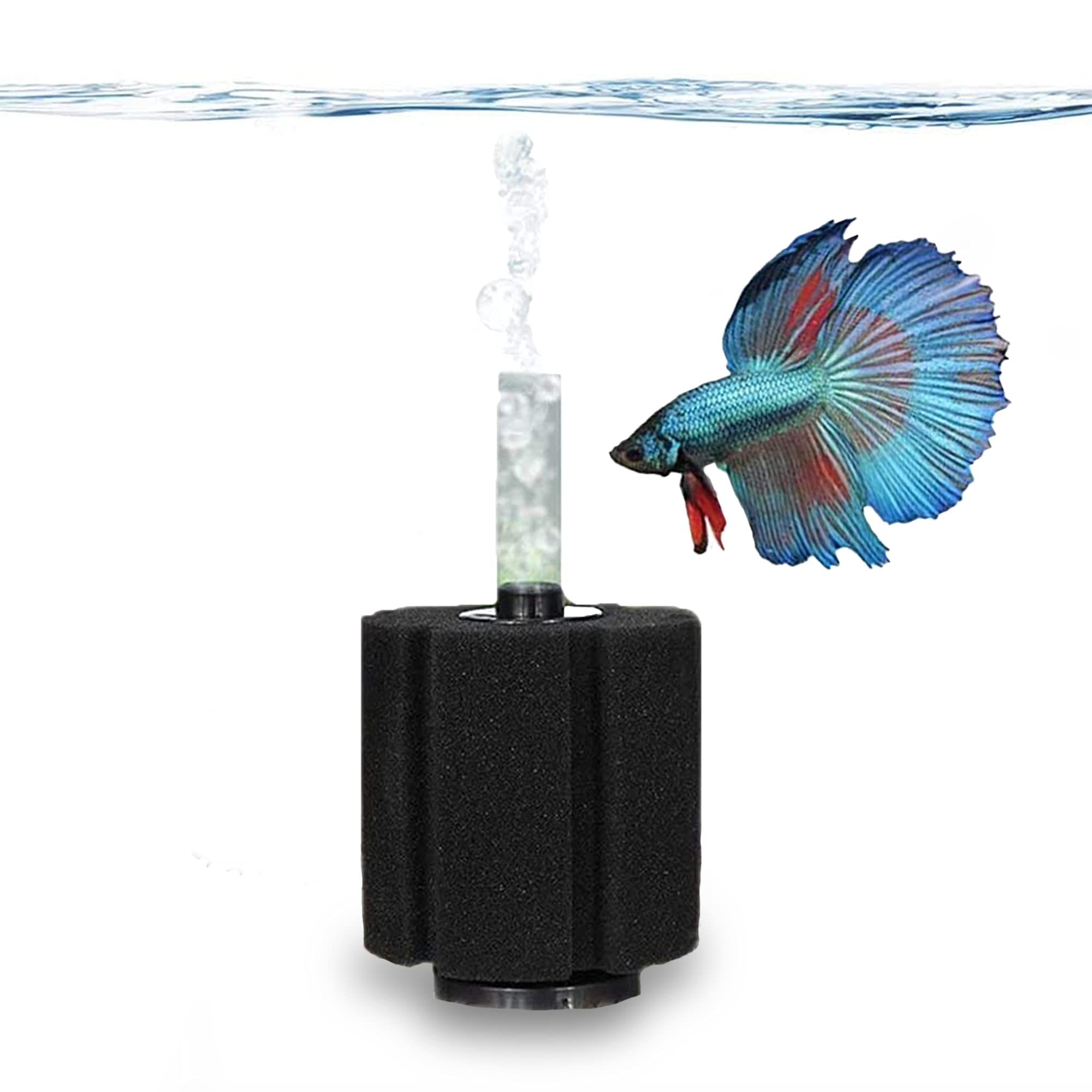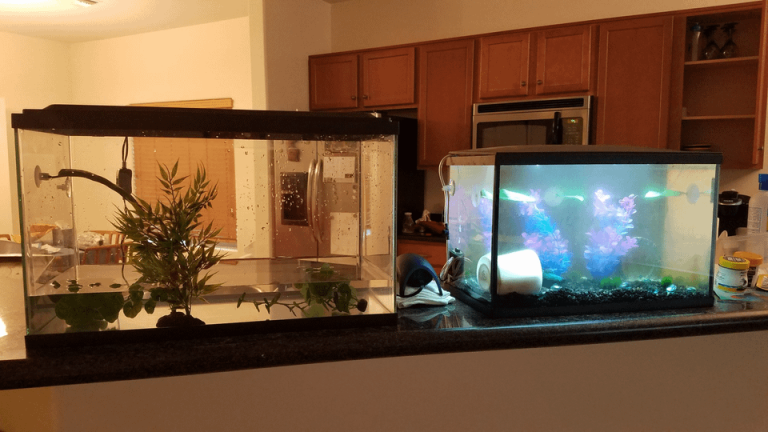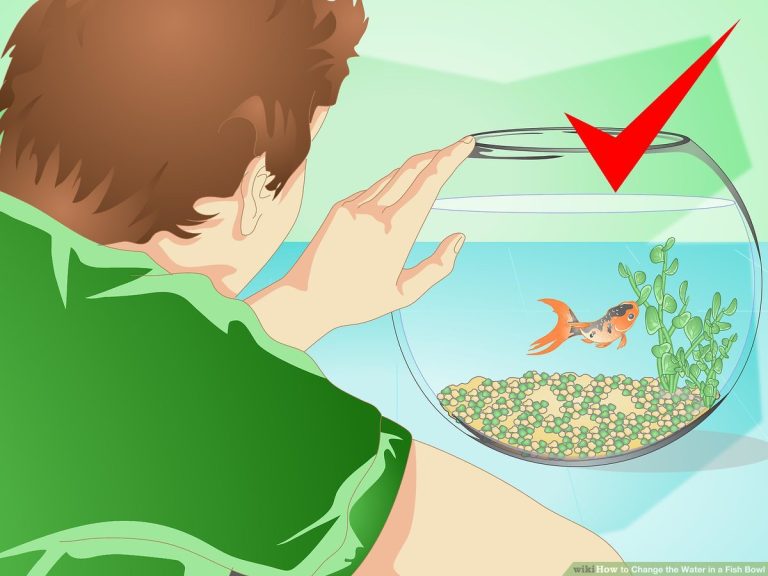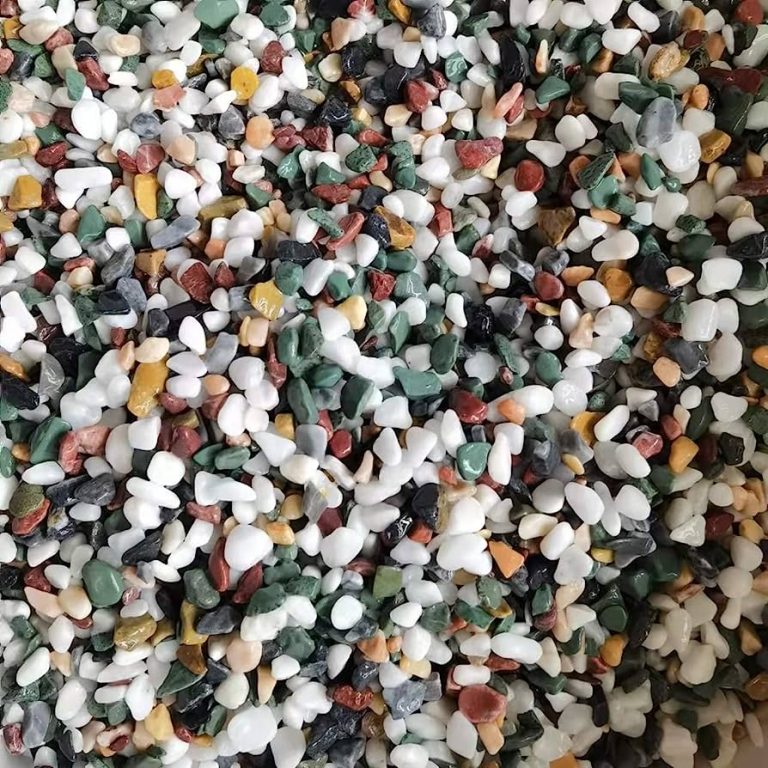Do Small Aquariums Need Air Pumps? Discover the Key Essentials!
Small aquariums do not necessarily need air pumps as long as they have adequate surface agitation to promote oxygen exchange. An air pump in a small aquarium may not be necessary if the tank has enough surface movement to ensure oxygenation, which is crucial for the health of aquatic life.
The decision to use an air pump depends on various factors like the number of inhabitants, the presence of live plants, and the size of the tank. Proper surface agitation can be achieved through filters or water circulation devices, which help oxygenate the water by breaking the surface tension.
Additionally, live plants can contribute to oxygen production during the day through photosynthesis. However, in some cases, particularly with densely stocked or heavily planted tanks, the use of an air pump can be beneficial to ensure optimal oxygen levels for fish and other aquatic organisms.

Credit: www.aquariumcoop.com
What Are Air Pumps And How Do They Work?
Definition And Purpose Of Air Pumps
Air pumps are an essential component of many aquarium setups, adding both practicality and aesthetic appeal to small aquariums. These devices are designed to pump air into the water, increasing the oxygen content and improving the overall health of the aquatic ecosystem.
The purpose of air pumps in small aquariums can be summarized as follows:
- Enhancing oxygen levels: Air pumps introduce air into the water, maximizing the dissolved oxygen content. This is especially important in small aquariums where oxygen exchange might be limited.
- Improving water circulation: Air pumps create water movement, promoting better circulation and preventing stagnant areas. This helps distribute nutrients evenly and prevents buildup of waste and debris.
- Reducing algae growth: Adequate aeration prevents the formation of algae blooms by hindering the growth of certain algae species that thrive in low-oxygen conditions.
- Providing visual appeal: The rising bubbles created by air pumps not only oxygenate the water but also create a captivating visual effect that enhances the overall aesthetics of the aquarium.
Explanation Of How Air Pumps Work
Air pumps operate through a simple mechanism that involves drawing in air from the atmosphere and propelling it into the water. The key points to understand about how air pumps function in an aquarium are:
- Motorized mechanism: Air pumps are typically powered by an electric motor that drives a diaphragm or piston.
- Air intake: The motorized mechanism pulls in air from the surrounding environment through an intake valve.
- Compression and displacement: Once inside, the air is compressed and then expelled through an outlet valve, usually via a rubber diaphragm or piston.
- Bubble production: As the compressed air is released into the water, it rises to the surface, generating small bubbles that disperse oxygen throughout the aquarium.
- Adjustable flow: Many air pumps feature adjustable controls that allow the aquarium hobbyist to regulate the air flow rate according to the specific needs of the aquatic inhabitants.
- Compatibility with accessories: Air pumps can be connected to various aquarium accessories, such as air stones, bubble wands, and sponge filters, which enhance the diffusion of air and further improve water movement and oxygenation.
By understanding the definition, purpose, and mechanics of air pumps, aquarium enthusiasts can make informed decisions about whether their small aquariums require the addition of an air pump.
Factors To Consider For Small Aquariums
Having a small aquarium can be an excellent way to bring the beauty of underwater life into your home or office. While air pumps are commonly used in larger aquariums, many people wonder if they are necessary for smaller setups.
There are several factors to consider when deciding whether or not to use an air pump in a small aquarium. Let’s take a closer look at these factors:
Size And Volume Of The Aquarium
The size and volume of your aquarium play a crucial role in determining if an air pump is necessary. Here are some key points to consider:
- For aquariums smaller than 10 gallons, an air pump may not be required as smaller volumes of water can naturally exchange gases with the atmosphere.
- If your small aquarium is heavily stocked with fish or contains delicate plants, an air pump can help increase water circulation and oxygenation.
- In aquariums larger than 10 gallons, an air pump can help maintain a consistent flow of oxygen throughout the tank and prevent stagnant areas.
Fish And Plant Requirements
Different fish and plant species have varying oxygen requirements. Consider the following points:
- Some fish, such as bettas and gouramis, have labyrinth organs that allow them to gather oxygen from the air. These fish may not require an air pump unless the tank is heavily stocked.
- Fish that prefer a strong current, like danios or tetras, may benefit from the additional water movement created by an air pump.
- Oxygen-loving plants, like amazon swords or water wisteria, thrive in well-aerated water. An air pump can be beneficial in supplying them with the necessary oxygen.
Oxygen Levels In Small Aquariums
Maintaining proper oxygen levels is essential for the overall health of your aquarium inhabitants. Consider these points:
- In a small aquarium, the surface area is limited, making it more prone to stagnant water. An air pump can create surface agitation, promoting gas exchange and increasing oxygen levels.
- Factors such as temperature, stocking density, and biological activity can all affect oxygen levels. Adding an air pump can help mitigate potential oxygen deficiencies.
While the use of an air pump in a small aquarium may not always be necessary, it can provide significant benefits in specific situations. By considering the size and volume of your tank, the needs of your fish and plants, and the oxygen levels within the aquarium, you can make an informed decision on whether to include an air pump in your setup.
Remember, a well-balanced and adequately oxygenated environment will contribute to the health and vitality of your aquatic companions.
Pros And Cons Of Using Air Pumps In Small Aquariums
If you have a small aquarium, you may be wondering if an air pump is necessary. Air pumps are often used in larger aquariums to provide additional oxygen and circulating water movement. However, their benefits in small tanks may not be as clear-cut.
In this section, we will discuss the pros and cons of using air pumps in small aquariums.
Advantages Of Air Pumps In Small Aquariums:
- Natural aeration and oxygenation: Air pumps help to increase the oxygen levels in the water, which is crucial for the health and well-being of your fish. By agitating the surface of the water, they enhance natural aeration and promote the exchange of gases, which helps fish breathe easier.
- Enhanced circulation and water movement: In small aquariums, stagnant water can lead to poor water quality and potential buildup of waste materials. Air pumps create water movement, helping to circulate the water and prevent the formation of dead zones. This promotes better filtration and oxygen distribution throughout the tank.
- Noise reduction and soothing effects: The sound of bubbling air from the pump can provide a calming and peaceful atmosphere in your aquarium. It can help mask other noise in your surroundings, creating a soothing environment for both you and your fish.
Disadvantages Of Air Pumps In Small Aquariums:
- Potential water disturbance: While air pumps can enhance water movement, excessive agitation may disrupt the peaceful environment of your small aquarium. Some fish, such as bettas, prefer calmer waters, and the strong bubbles created by an air pump may cause stress or discomfort.
- Cost and maintenance considerations: Air pumps require additional equipment, such as air stones and tubing, which adds to the overall cost. Moreover, they need regular maintenance to prevent clogs or buildup of unwanted debris. If not properly maintained, air pumps can become noisy and inefficient in the long run.
The use of air pumps in small aquariums has both pros and cons. It is important to consider the specific needs of your fish species and the overall aesthetics you desire in your tank. While air pumps can provide benefits like increased oxygenation and water movement, they may also disrupt the tranquility and add additional costs.
Evaluate your aquarium setup and the needs of your fish before deciding whether an air pump is necessary for your small aquarium.
Key Essentials For Small Aquariums Without Air Pumps
Aquarium Setup And Layout
Having a small aquarium can be a delightful addition to any living space. While air pumps are commonly used in larger aquariums to provide oxygen and water circulation, small aquariums may not necessarily require them. In fact, there are several key essentials that can ensure the well-being of your aquatic pets without the need for an air pump.
Strategic Placement Of Plants And Decorations
One of the primary considerations when setting up a small aquarium without an air pump is the strategic placement of plants and decorations. These elements play a crucial role in maintaining a healthy and balanced ecosystem for your fish. Here’s how you can make the most out of their placement:
- Incorporate live plants: Live plants act as natural oxygenators, releasing oxygen into the water during photosynthesis. Opt for species such as hornwort, anacharis, or java moss that have high oxygen production. Place them strategically around the aquarium to provide oxygen to the fish and create a visually appealing environment.
- Utilize aquarium decorations: Decorative elements like rocks, driftwood, or ceramic structures not only enhance the aesthetic appeal of the aquarium but also serve functional purposes. Placing decorations strategically can create pockets of calm water where fish can rest or seek refuge, reducing the need for excessive water circulation.
- Consider the fish’s natural habitat: When placing plants and decorations, mimic the fish’s natural habitat as much as possible. Research the preferences of your chosen fish species and arrange the aquarium to resemble their native environment. This not only promotes their well-being but also makes them feel more comfortable and less stressed.
Selecting Suitable Fish Species
Choosing the right fish species for your small aquarium is essential for maintaining a thriving ecosystem. Consider the following factors when selecting fish:
- Size and activity level: Opt for small and peaceful fish species that are suitable for confined spaces. Avoid aggressive or territorial fish that may require larger territories or more active swimming space.
- Oxygen requirements: Some fish species, like bettas, labyrinth fish, or guppies, have a higher tolerance for low oxygen levels and can adapt well to small aquariums without air pumps. These species are capable of obtaining adequate oxygen from the water surface alone.
- Temperature and water quality preferences: Different fish species have specific temperature and water quality requirements. Choose fish that can comfortably thrive in the water parameters you can provide without the need for additional equipment like a heater or filter.
Remember that regular maintenance, including water changes and proper feeding, are vital for the health and well-being of your fish in small aquariums. By implementing these key essentials, you can create a thriving aquatic environment without the need for an air pump.
Alternative Methods For Aeration In Small Aquariums
Small aquariums may not always need air pumps for aeration. While air pumps can be useful for maintaining oxygen levels in larger aquariums, finding alternative methods for aeration in small aquariums can save space, reduce noise levels, and potentially lower costs.
In this section, we will explore three alternative methods for aeration in small aquariums: utilizing sponge filters, water surface agitation techniques, and incorporating live plants for oxygenation.
Utilizing Sponge Filters
- Sponge filters offer both mechanical and biological filtration, making them a suitable choice for small aquariums.
- The sponge acts as a medium for beneficial bacteria to colonize and convert harmful toxins into less toxic substances.
- They provide a gentle water flow, creating oxygenation without the need for an air pump.
- Sponge filters are easy to clean and maintain, making them a practical option for beginners and experienced aquarium enthusiasts alike.
Water Surface Agitation Techniques
- Creating water surface agitation can enhance oxygen exchange in the aquarium.
- Utilizing a small submersible water pump, such as a powerhead or mini wave maker, can generate water movement and promote aeration.
- Air stones or bubble wands can also be implemented to create surface agitation, increasing oxygen levels in the water.
- It’s important to strike a balance with the water flow, ensuring it’s not too strong to distress the fish or disturb the aquatic environment.
Live Plants For Oxygenation
- Incorporating live plants in a small aquarium not only adds aesthetic appeal, but also assists in oxygenation.
- Through the process of photosynthesis, plants absorb carbon dioxide and release oxygen, improving water quality.
- Certain plant species, like anubias, vallisneria, and amazon sword, are particularly efficient at oxygenating the water due to their rapid growth and high oxygen production.
- Live plants also provide additional benefits such as natural filtration and a habitat for small organisms.
By utilizing sponge filters, employing water surface agitation techniques, and incorporating live plants for oxygenation, small aquarium owners can maintain adequate levels of oxygen without the need for air pumps. These alternative methods offer practical and effective solutions for aeration while promoting a healthy and thriving aquatic environment.
Frequently Asked Questions Of Do Small Aquariums Need Air Pumps
Do Small Aquariums Need Air Pumps?
Small aquariums do not necessarily need air pumps, as long as they have an efficient filtration system and adequate water movement.
Why Are Air Pumps Important For Aquariums?
Air pumps provide oxygen to the water, improve water circulation, and create surface agitation to promote gas exchange.
What Are The Benefits Of Using Air Pumps In Small Aquariums?
Air pumps help prevent the formation of stagnant areas, promote a healthy environment for aquarium inhabitants, and enhance overall water quality.
Can I Use An Air Stone Without An Air Pump In My Small Aquarium?
No, an air stone relies on an air pump to generate the necessary air bubbles for oxygenation and water movement.
Conclusion
After careful consideration, it is evident that air pumps are not absolutely necessary for small aquariums. While they can provide beneficial oxygenation and water movement, they are not essential for the survival of fish and other aquatic life in a small tank.
Factors such as tank size, species of fish, and other methods of oxygenation must be taken into account before deciding whether to use an air pump. Remember, regular water changes, proper filtration, and adequate surface agitation can provide sufficient oxygen levels for a small aquarium.
It is important to assess the specific needs of your aquatic pets and tailor the setup accordingly. By understanding the dynamics of your tank and addressing its requirements, you can create a thriving and healthy environment for your fish without the added expense and maintenance of an air pump.
Choose the setup that works best for your specific circumstances and enjoy the beauty and tranquility of your small aquarium.






